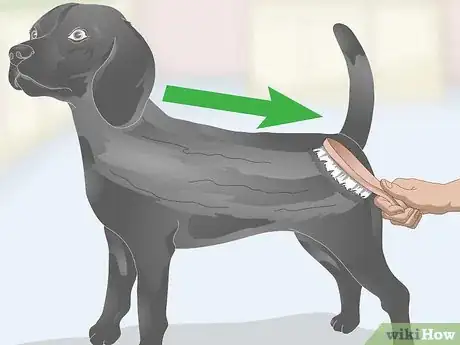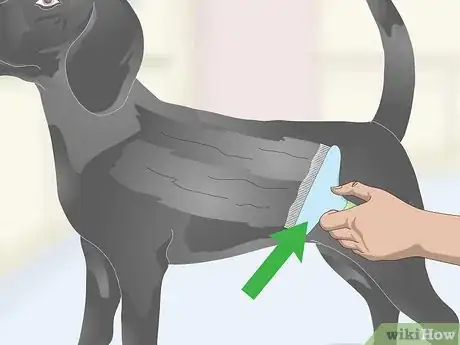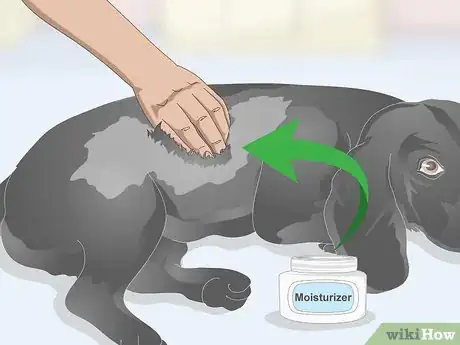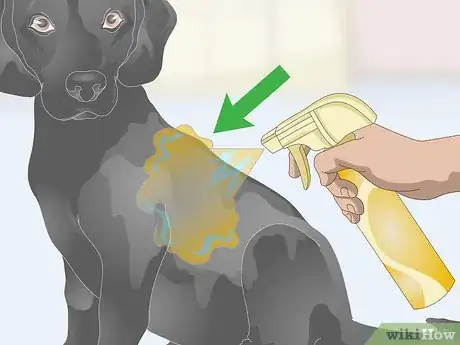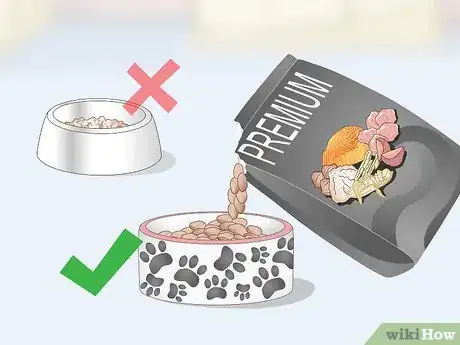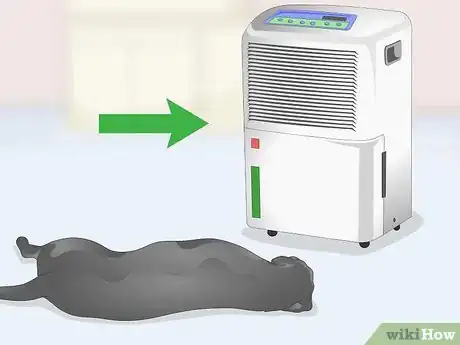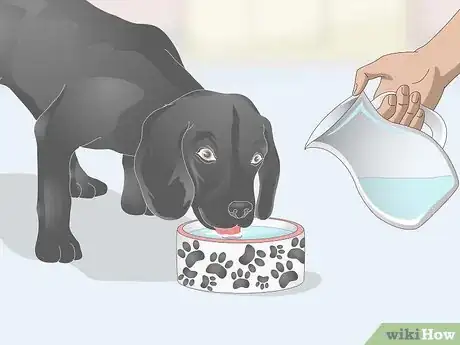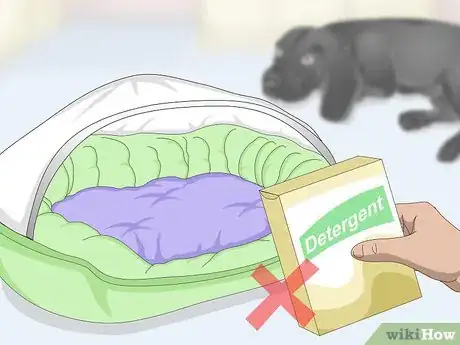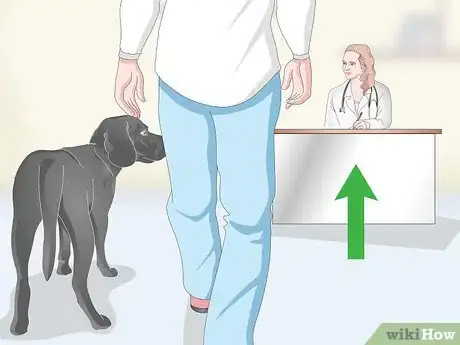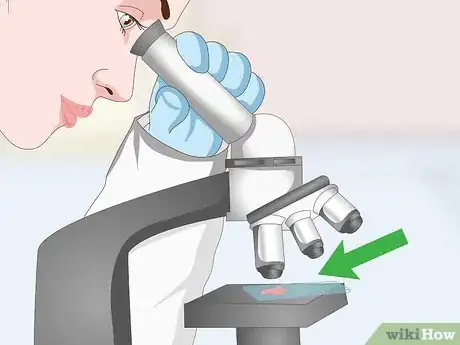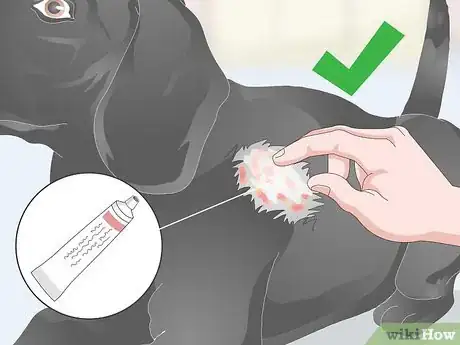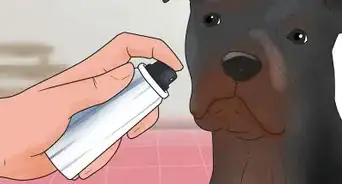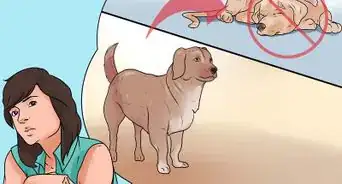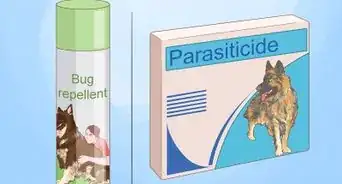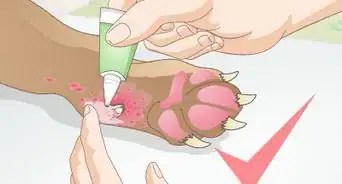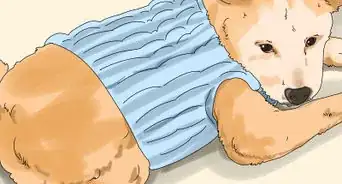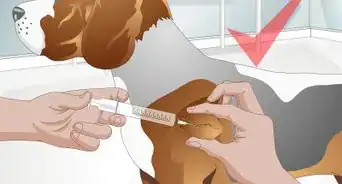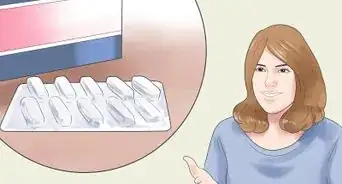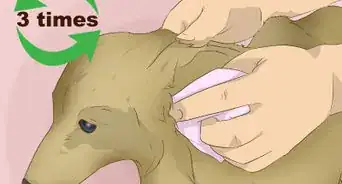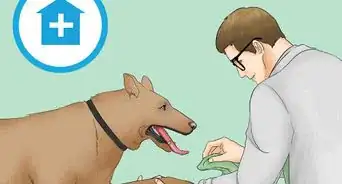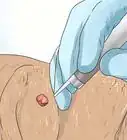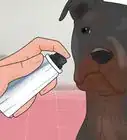This article was co-authored by Deanne Pawlisch, CVT, MA. Deanne Pawlisch is a Certified Veterinary Technician, who does corporate training for veterinary practices and has taught at the NAVTA-approved Veterinary Assistant Program at the Harper College in Illinois and in 2011 was elected to the board of the Veterinary Emergency and Critical Care Foundation. Deanne has been a Board Member of the Veterinary Emergency and Critical Care Foundation in San Antonio, Texas since 2011. She holds a BS in Anthropology from Loyola University and an MA in Anthropology from Northern Illinois University.
This article has been viewed 28,782 times.
It can be upsetting to watch your dog struggle with dandruff as no one wants their pet itchy and unhappy. Luckily, dandruff in dogs is rarely serious and can usually be treated successfully with grooming and lifestyle changes. In rare cases, the problems persist after treatment and you may need to talk to your vet. However, the vet should be able to come up with a care plan that will get your dog back on track to health.
Steps
Grooming Your Dog Regularly
-
1Take your dog to the vet for a proper dandruff diagnosis. What looks like dandruff could be scabies or walking dandruff. Scabies and walking dandruff are skin conditions caused by mites, which can cause irritation, discomfort, and health issues for your dog.[1] While these conditions resemble dandruff, they require a different treatment that your vet can prescribe. Before you attempt to address the problem with grooming, you should get a proper diagnosis.
-
2Use long strokes when brushing your dog. Brushing your dog each day can help reduce symptoms of dandruff, but how you brush makes a big difference. When brushing your dog, always brush with the line of the coat using long, sweeping strokes. This helps remove dirt and debris from your dog's coat and stimulates oil production in your dog's skin, leading to a reduction in dandruff.[2]Advertisement
-
3Switch combs during the brushing process. Have several combs on hand when brushing your dog. Start off with a coarse brush you can use to remove tangles. Then, move to a brush with softer bristles. When you're done brushing, gently rub down your dog's fur with an old towel to pick up any dust and dandruff you removed while brushing.[3]
- Do this outside or on a tile or laminated floor that's easy to clean.
- Both long and shorthaired dogs benefit from daily brushing.
-
4Invest in an anti-dandruff shampoo. Stop by a pet store or veterinary office and pick up a special anti-dandruff shampoo designed for use on dogs. Regular bathing with an anti-dandruff shampoo can help moisturize your dog's skin to prevent the build up of dandruff. This can also prevent dandruff in dogs with healthy skin.[4]
- Over-bathing can actually make dandruff worse, as it will dry out your dog's skin. Stick to bathing your dog no more than once a week to help reduce dandruff.
-
5Massage moisturizer into your dog's skin. Under the direction of a veterinarian, an all-natural hand cream can actually be used on dogs. You can simply massage your regular hand cream into your dog's skin once every few days to moisturize your dog's skin, helping to prevent dandruff.[5]
- For best results, go for a lotion containing colloidal oatmeal.
- Make sure to massage the lotion completely into your dog's skin so they do not lick it off and ingest it. You may have to part the hair to reach the skin, especially with longhaired dogs.
-
6Squirt oils onto your dog's skin. Pet stores sell bottles of holistic pet oils that can help replenish fluid in dry skin. This can lead to a reduction in dandruff. Pick up a bottle of organic oils designed specifically for dogs and spritz your dog down with the oils according to the package directions.[6]
- How often you use the oil depends on the type you buy. Some may be made for daily use, while the others should only be used once a week or every few days.
Making Lifestyle Changes
-
1Switch to a higher quality dog food. If your dog's dandruff is severe, switch to a higher quality dog food. Go from a department store brand to a brand sold in a vet's office, for example, and opt for all-natural and organic foods. Some dogs eventually experience a reduction in dandruff symptoms after a few weeks on a healthier diet.[7]
- Always switch between brands of dog food gradually. Mix in small amounts of the new food with the old food, gradually replacing the old food altogether within a few weeks.
- It's okay to switch dog food brands on your own, but don't add any supplements to your dog's food without consulting a vet first.
- If your dog has a sensitive stomach, talk to a vet first. You can also contact your vet if your dog starts experiencing symptoms like vomiting.
-
2Invest in a humidifier. Dry air can increase your dog's risk for dandruff. If your home is dry, try investing in a humidifier. Keep a humidifier running in areas of your home where your dog tends to play. This may lead to a reduction in dandruff.[8]
- Most people and animals are comfortable when humidity levels are between 40 and 60 percent.[9]
-
3Make sure your dog gets plenty of water. If your dog is well hydrated, their skin will stay moisturized as well. Have clean, fresh water out at all times in a spot your dog can easily reach.[10]
- Check the water bowl regularly throughout the day and add more water if the bowl is empty or dirty.
-
4Limit your dog's exposure to potential allergens. Pay attention to when your dog tends to have dandruff breakouts. This can help you determine if dandruff is caused by an allergen. If you identify a potential allergen, try limiting your dog's exposure to it and see if it reduces symptoms.[11]
- For example, if your dog has dandruff outbreaks after you wash its bed, it may be allergic to the detergent you're using. Try switching your detergent.
- If your dog's outbreaks tend to occur during certain times of the year, your dog may allergic to things like pollen. Try keeping your dog indoors more often during seasonal changes to reduce symptoms.
Seeking Veterinary Care
-
1Make an appointment with your vet if the problem does not clear up. If extra grooming and lifestyle changes do not help, make an appointment with your vet. Dandruff is rarely serious, but can sometimes be a sign of an underlying health condition like parasites or immune issues. Only a vet will be able to determine if underlying factors are contributing to your dog's dandruff.[12]
-
2Let the vet test for underlying issues. Your vet may want to perform different tests depending on the suspected condition. Answer any questions your vet has about your dog's behavior and let them know about any other symptoms you've noticed. Your vet will decide what kind of tests to run from here.[13]
- Your vet may want a stool sample to test for parasites.
- If allergies are suspected, your vet may want to run an allergy test.
- Blood work may be needed if your vet suspects an underlying health condition like an immune disorder.
-
3Ask about introducing supplements to your dog's diet. A diet is sometimes the culprit for excessive dandruff. Dandruff in some dogs can be successfully treated with supplements like fish oil and omega 3 fatty acids.[14]
- Never introduce supplements without consulting a vet first.
-
4Talk about special ointments and cream. Special ointments and creams are sometimes used to treat the symptoms of allergies that may cause dandruff. If your dog has fleas, your vet may also have a topical cream they want you to apply. Your vet can give you instructions to help you administered any topical treatments correctly.[15]
References
- ↑ https://pets.webmd.com/dogs/mange-dogs-canine-scabies#1
- ↑ http://www.akc.org/content/health/articles/dog-dry-skin-dandruff/
- ↑ http://www.akc.org/content/health/articles/dog-dry-skin-dandruff/
- ↑ http://www.petmd.com/dog/grooming/evr_multi_dandruff_free_pet?page=show
- ↑ http://www.petmd.com/dog/grooming/evr_multi_dandruff_free_pet?page=show
- ↑ http://www.petmd.com/dog/grooming/evr_multi_dandruff_free_pet?page=show
- ↑ http://www.petmd.com/dog/grooming/evr_multi_dandruff_free_pet?page=show
- ↑ http://www.petful.com/pet-health/dog-dandruff-causes-treatments/
- ↑ http://www.startribune.com/fixit-what-is-the-ideal-winter-indoor-humidity-level/11468916/
- ↑ http://www.petful.com/pet-health/dog-dandruff-causes-treatments/
- ↑ https://thehappypuppysite.com/dog-dandruff/
- ↑ http://www.akc.org/content/health/articles/dog-dry-skin-dandruff/
- ↑ http://www.petful.com/pet-health/dog-dandruff-causes-treatments/
- ↑ https://thehappypuppysite.com/dog-dandruff/
- ↑ http://www.petful.com/pet-health/dog-dandruff-causes-treatments/
About This Article
If your dog has dandruff, brush it each day using long, sweeping strokes in the direction of its fur growth. This helps remove dirt and debris and stimulates oil production in your dog's skin, leading to a reduction in dandruff. To help moisturize your dog’s skin, use a dandruff shampoo once per week, and massage moisturizing lotion into its skin every few days. Dehydration can increase your dog's risk for dandruff, so give it plenty of water to drink, and consider investing in a humidifier to prevent its skin from drying out. For more tips from our Veterinary co-author, like how to have your dog tested for possible underlying conditions, keep reading!
